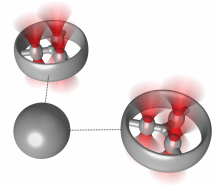Mar 15 2019
Researchers from the Universities of Glasgow, Bristol, and Exeter have developed a new technique of shifting microscopic objects using micro-robotics.
 The research team has developed a new technique that enables optical trapping without focussing any laser light onto the trapped particles. (Image credit: Exeter University)
The research team has developed a new technique that enables optical trapping without focussing any laser light onto the trapped particles. (Image credit: Exeter University)
At present, optical tweezers—which are employed to examine DNA, proteins, biological molecular motors, and the inner life of cells—use light to hold objects as small as a single nanoparticle in a specific place. They use the rare optical forces formed by securely focused laser beams to capture and control particles, fundamentally acting as “microscopic hands” for researchers.
In the 1970s, the first optical tweezers were built by Dr Arthur Ashkin. Since then, a series of innovations have enabled researchers to exploit complex objects such as cells and viruses. Dr Ashkin, currently in his 90s, was in recent times awarded the Nobel Prize in Physics in 2018 for his groundbreaking work.
However, this current technique has boundaries—the high intensities of light needed by optical tweezers can harm live biological samples, and also limit the types of objects that can be contained.
Currently, the researchers have formulated a new method that allows optical trapping without focusing any laser light onto the captured particles.
To achieve this they have created optically trapped micro-rotors, which are positioned in the liquid surrounding the particle, and used to control its movement using fluid flow.
When the micro-rotors are rotated, they form a wave in the liquid that applies a force on the particle—quite like the way that a jet of water in a Jacuzzi can move things away.
By regulating the directions of each micro-rotor, researchers can either shift the particle to a specific location or contain it in a single spot—allowing particles to be imaged or sorted at high resolution.
Importantly, this new method allows scientists to use flow to locate one specific particle at a time, and not disturb others in nearby.
The study has been published in the leading journal Nature Communications.
This research expands the applications of optical tweezers to trap particles of any material in a liquid environment, and without risk of photo-damage, and adds to the toolbox of techniques that allow us develop new nanotechnologies.
Dr Phillips, Study Senior Author, Physics Department, University of Exeter.